Thresher Sharks
Alopiidae

Thresher Shark
|
Thresher Sharks are also known as Fox Sharks, Swing Tails, Swivel Tails or Long Tailed Sharks. They are easily identified by their heterocercal caudal fin. The lobes are extremely unequal and the length of the upper lobe can be equal to, or longer than, the shark's body. |
|
Though mostly solitary, they have been known to hunt in pairs by working to keep fish herded into tight and easy to eat groups.
Thresher Sharks Hunting
The family consists of 3 species in one genus.
|
|
Characteristics
- General Body Shape - These sharks have a small head with a conical shaped nose and a torpedo shaped body. They range in size from 300cm for males and between 370 and 400cm for females. They may get as long as 610cm total length in extreme cases.
Despite their large size they are capable of breaching fully out of the water.
- Eyes - All three sharks have large eyes but the Bigeye has the largest. No surprises there then ;)
- Teeth - The teeth in the upper and lower jaws are similarly shaped. They are small, curved, smooth and very sharp.
- Gills - They have five pairs of gills. They are short and the forth and fifth pairs are situated above the pectoral fins.
- Fins - The most obvious fin is the whip-like caudal fin. It's curved and can be as long as the body of the shark. They also have large pectoral, pelvic and first dorsal fins, with a very small second dorsal fin.
These fish are found in tropical to colder temperate seas. They're found in both coastal waters and the deep pelagic waters. They prefer the deep open ocean but will come close inshore to feed.
They are ovoviviparous with oophagy and, depending on species, give birth to between two and six pups at a time. They reach sexual maturity at about 14 years of age.
Though they are large sharks they are of little danger to humans. They are not known to be aggressive and the main danger is to divers getting an accidental swipe with the tail.
Well, if my greyhound can't control his, what hope is there for a shark with one the length these guys have?

Amazing Tail
Recent Articles
-
Thresher Sharks
Aug 27, 14 10:51 AM
Thresher sharks are unmistakable with that huge upper lobe on the caudal fin. Let's find out more about them. -
Sharkwater
Aug 14, 14 12:42 PM
Sharkwater is a documentary by Rob Stewart highlighting the plight of the sharks in our oceans. -
Natural Cleaners
Aug 13, 14 08:57 AM
Natural cleaners and homemade skincare products are not only better for the environment, they're better for you and your family.
